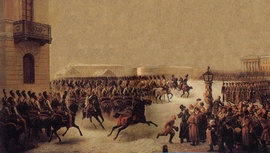Rediscovering Pushkin
A few days ago my wife came home from the library with Martha Fienne's adaptation of Pushkin's Onegin. I so enjoyed watching it last night that I will be reading some of Pushkin's short stories as well. Watching the DVD was helpful- allowing me to listen to some interesting story commentary.
The story may also serve as a social commentary about bored/spoiled aristocratic Russia- showing why the roots of the 1917 Revolution were likely sown at least a century earlier.

The movie takes place in 1830's St.Petersburg (shortly before Pushkin was killed in a duel- not unlike in the story). And I remember that the Decembrist Revolt (pictured above), instigated by restless imperial soldiers wanting political reform, occurred in St. Petersburg perhaps less than a decade earlier. Not incidentally, imperial soldier from St. Petersburg play an important periphery part in Eugene Onegin. Indeed, suspicion fell on Aleksandr Pushkin for being on friendly terms with several Decembrist leaders.



